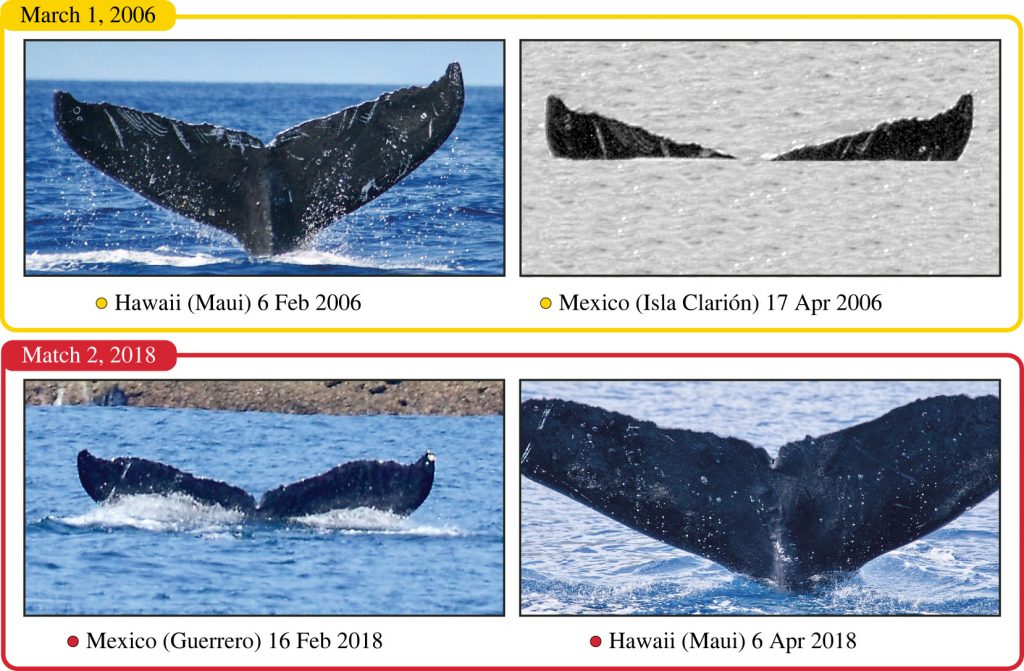Whale tails reveal travel between Hawaiʻi and Mexico in same breeding seasons
A collaborative study by six international research organizations revealed the discovery of two humpback whales that traveled between the breeding grounds of Hawai’i and Mexico – about 3,728 miles – in the same winter.
The study’s first whale was photographed off West Maui on Feb. 23, 2006, and then identified 53 days and 2,824 miles later in the Mexico breeding ground on the southern shore of Isla Clarión.
The second whale made the opposite trip. On Feb. 16, 2018, the whale was spotted south of Zihuatanejo Guerrero, Mexico, and 49 days and 3,693 miles later, it was re-photographed off West Maui.
The study was published in Biology Letters, a scientific journal published by the Royal Society. The contributors used photographs to identify individual whales in different parts of the Northeast Pacific.
Humpback whales have unique markings on the underside of their tail, much like the uniqueness of human fingerprints. These images are shared in a global database called Happywhale, allowing researchers and whale watchers to match images and track distribution and migration patterns of humpback whales across the Pacific.
“It has been exciting to collaborate with all the authors and contributors whose hard work – when combined with the computerized matching software of Happywhale – made this discovery,” said the study’s lead author, Dr. Jim Darling of Maui-based Whale Trust.
It has been presumed that the two breeding grounds in Mexico and Hawaiʻi were seasonally isolated, meaning whales leave northern feeding grounds and migrate to only one breeding area before returning to their feeding grounds.
These discoveries, combined with other lines of evidence including the similarity of complex and changing songs between Mexico and Hawaiʻi and the recent detection of humpback song halfway between Mexico and Hawaiʻi in winter by an autonomous wave glider, indicate that mixing between Hawaiʻi and Mexico whales may be more common than previously thought.
“It is sightings and connections like these that keep us out on the water and happy at our desks, searching for more pieces to the puzzle,” said Katherina Audley, Founder and Director of Whales of Guerrero.
Currently, humpback whales in Mexico and Hawaiʻi are designated as Distinct Population Segments by the National Marine Fisheries Service. But mounting evidence now suggests that humpback whales may use the ocean at a larger scale than previously known, raising several questions — are humpback whale breeding groups truly distinct, or an integrated community sharing an entire ocean? Is this type of interchange between breeding grounds an unusual event or something more common? Are current distribution and migration maps of humpback whales in the North Pacific more a reflection of humans than whales?
“These findings are a reminder that the biology of humpback whales, as for many animals, is not simple,” said study co-author Ed Lyman of the Hawaiian Islands Humpback Whale National Marine Sanctuary.
Collectively, these discoveries challenge our current understanding of how humpback whales move around the North Pacific Ocean and have implications for how we develop policies to identify and protect humpback whale populations.
“One thing for sure, we have not figured these whales out yet, not even close,” said Dr. Darling, who has been studying humpback whales for nearly five decades.
The research organizations included in the study: Whale Trust, Whales of Guerrero, Hawaiian Islands Humpback Whale National Marine Sanctuary, Happywhale, Eye of the Whale Marine Mammal Research, and the Departamento Académico de Ciencias Marinas y Costeras at Universidad Autónoma de Baja California Sur.












